The Decline And Fall Of Roman London Walk Sat 1.30pm 25th May 2024 Exit 2 St Pauls Underground Station. To Book
Jane Austen’s London Sat 6pm 25th May 2024 Green Park Tube (Green Park exit, by the fountain) to Book
The Peasants Revolt Anniversary Walk Thurs 6.30 13th June 2024 Aldgate Tube. To book
Chaucer’s Medieval London Guided Walk Sat 2.30pm 6th July Aldgate Tube. To Book
Myths, Legends, Archaeology and the Origins of London Sat 6pm July 6th 24 Tower Hill Underground To book
Roman London – A Literary & Archaeological Walk Sun 11.30 am 4th August 2024 Monument Underground Station To book
1066 and All That Walk Sat 2.30pm 9th Nov 24 Blackfriars Underground Station To book
For a complete list of my walks for London Walks in 2024 look here:
May 8th Helston Furry Dance
At the end of the May Day/Beltane Festival Helston in Cornwall holds its Furry (or Floral) Dance. It is normally on the 8th May, but it changes date if the 8th is a Sunday or a Monday (Helston’s market day) but it isn’t so the Floral Dance was held this year on Wednesday 8th 5th May.
Padstow holds, perhaps, the most famous May Day festival on May 1st. Padstow feels more of a ‘pagan’ festival, while Helston is a more sedate, gentlemanly, dance. Padstow is more fuelled by a belly full of ale, while Helston by a Pims No 1, or a Gin and Tonic?
Do, have a look at both youtube videos and watch the Padstow one until at least you see the ‘obby ‘orse and the teaser dancing.
Children born between the two days, May 1st and May 8th are considered to have been ‘born with the skill of man and beast and power over both.’
May the Bees be with you! May 5th
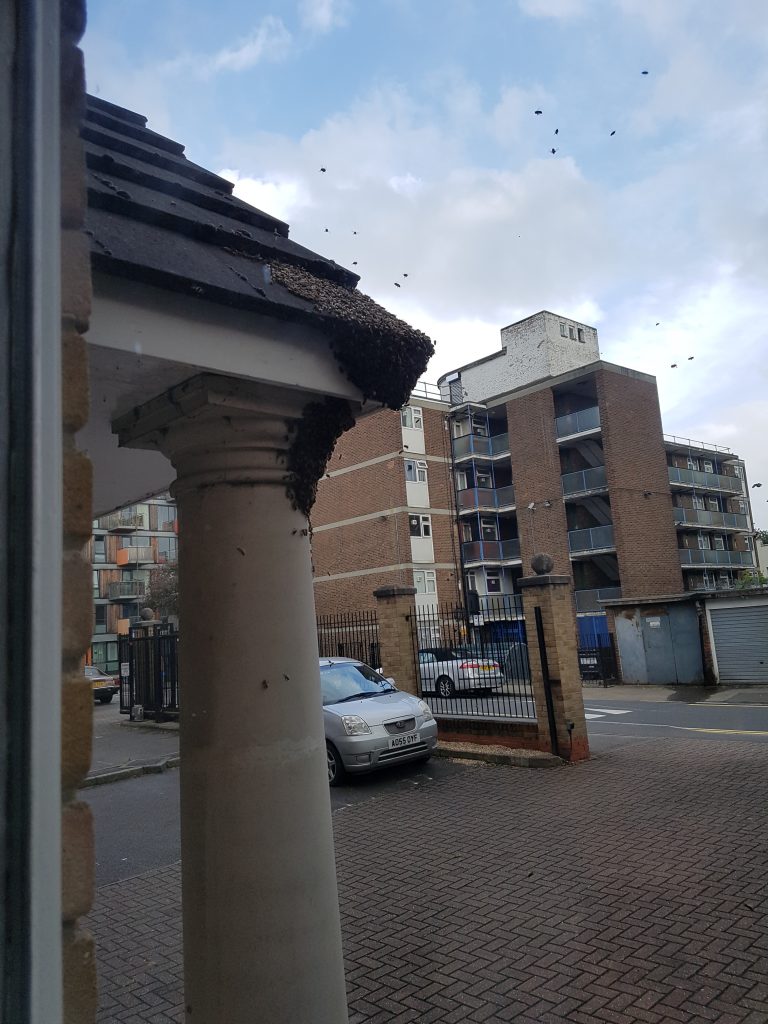
Tusser’s ‘Five Hundred Points of Good Husbandry’ published 1573 suggests we should:
‘take heed to thy Bees, that are ready to swarm, the loss thereof now, is a crown’s worth of harm.’ The loss was particularly hard in May or June as the country verse tells us:
A swarm in May
Is worth a load of hay
A swarm in June
Is worth a silver spoon
A swarm in July
Is not worth a fly.
In 2018, on 30th May, I was perturbed to find a swarm of Bees hanging outside my front door. Frightened of leaving my house, I rang a local Bee Keeper who came around to take possession of the Bees and take them to a new home.

According to Hillman’s ‘Tusser Redivus’ of 1710, swarming in May produces particularly good honey, and he advises following the bees to retrieve them. He says:
‘You are entitled by custom to follow them over anyone’s land and claim them … but only so long as you ‘ting-tang’ as you go, by beating some metal utensil – the sound whereof is also said to make your bees stop.’
Much of the above is from The Perpetual Almanac of Folklore by Charles Kightly.
Bees swarm when a new Queen Bee takes a proportion of the worker bees to form a new colony. They will latch unto a branch or a shrub, even a car’s wing mirror, while sending bees out searching for a suitable new home, such as a hollow tree. There may be hundreds or even thousands in the new colony, and this may be very alarming, as I found, as I could not go out without walking through a cloud of bees. But, at this point, they will not be aggressive as they do not have a hive to protect. Look here for more information on swarming.
An average hive will produce 25 lbs of honey, and the bees will fly 1,375,000 miles to produce it, which is flying 55 times around the world (according to the British beekeepers Association (and my maths)) https://www.bbka.org.uk/honey
Bees are still having a hard time as their habitats are diminishing and threats increasing. In July, DEFRA hosts ‘Bees Needs Week’ which aims to increase public awareness of the importance of pollinators.
They suggest we can help by these 5 simple actions
- Grow more nectar rich flowers, shrubs and trees. Using window or balcony boxes are good options if you don’t have a garden.
- Let patches of garden and land grow wild.
- Cut grass less often.
- Do not disturb insect nests and hibernation spots.
- Think carefully about whether to use pesticides.
For more above Bees Needs Week look here:
May the 4th be with you

Should have got this out yesterday because it was Star Wars Day. This is based on the flimsy premise that ‘May the 4th be with you’ is similar to ‘May the Force be with you’.
In the UK Census of 2011, 390,127 self-declared themselves as Jedi under the question about religion. However, ten years later, the number declined to a mere 1,600. The cause appears to be a call from the Humanists to use ‘No religion’ as rather than declare as a Jedi Knight.
To find out what went down on Happy Star Wars day, look at this website:
Roodmas, the True Cross and the Coronation May 3rd
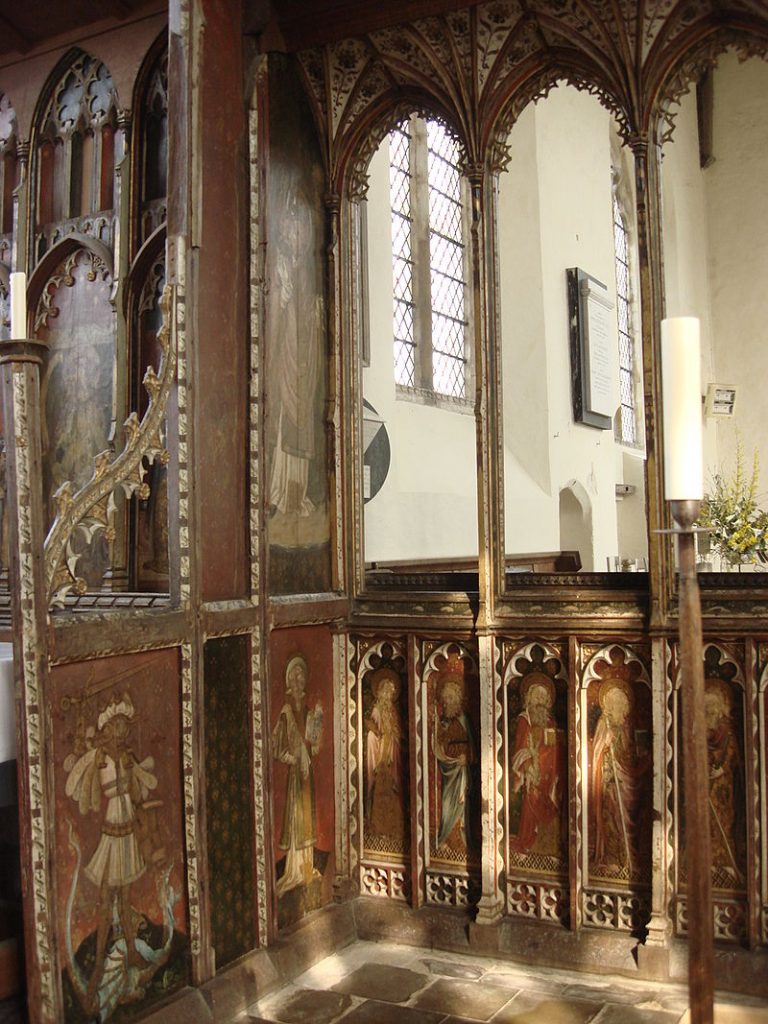
Roodmas is celebrated on May 3rd and September 14th, although the Church of England aligned itself with the Catholic Church’s main celebration on September 14th.
Rood is another word for the Cross. Parish Churches used to have a Rood Screen separating the holy Choir from the more secular Nave. This screen was topped with a statue of the Crucified Jesus nailed to a Rood.
The two dates of Roodmas reflects that it commemorates two events:
The Discovery of the Holy Cross in Jerusalem in 326 by Queen Helena, wife of Constantius Chlorus and mother of Constantine the Great. In Jerusalem, Queen Helena found the Cross with the nails, and the crown of thorns. She authenticated the Cross by placing it in contact with a deathly sick woman who was revived by the touch of Cross. She had most of the Cross sent back to the care of her son, Constantine the Great.
The part of the Holy Cross that was left behind in Jerusalem was taken by Persians but recovered by the Byzantine Emperor Heraclius in 628 in a peace treaty.
Over the years, the Cross was shivered into ever smaller pieces as Emperors, Kings, Queens, Dukes, Counts, Popes, Bishops, Abbots, and Abbesses swapped relics with each other. The fragments were cased in beautiful reliquaries and had enormous power for those of faith and those who could be helped by healing by faith.
The Duke of Buckingham had a piece in his collection, which he kept at York House in the early 17th Century. How he got it, I don’t know, but I think he must have acquired it from the aftermath of the destruction of the Reformation. John Tradescant, who looked after the Duke’s collection (before Buckingham was murdered), had a wonderful collection of curiosities which he kept in the UK’s first Museum in Lambeth. Tradescant’s Ark, as his museum was called, also had a piece of the True Cross. Again, I suspect (without any evidence) that he got it from Buckingham. Did he acquire it after the murder? Or shiver off a timber fragment hoping no one would notice?
The Chapel that Shakespeare’s Father controlled as Bailiff of Stratford on Avon, was dedicated to the Legend of the True Cross, to find out more click here:

Last year, I was just finishing this piece when I came across this astonishing story in the Shropshire News!
It seems two pieces of the True Cross were given to Charles III by the Pope! They have been put into a cross called the Welsh Cross which took part in the Coronation Procession, and then the King is giving the Cross (I assume with the pieces of the Holy Cross) to the Church in Wales. Let the Shropshire News tell the story:

This is quite extraordinarily medieval, and fits in with the news that we were encouraged to take an oath of allegiance to the new King.
I, (Insert full name), do swear that I will be faithful and bear true allegiance to His Majesty King Charles, his heirs and successors, according to law. So help me God.

It is a clear reminder that we are subjects not citizens and news, as a nation, we still set store by superstitions.
First Written on May 3rd 2023, revised May 3rd 2024
This Stinking Idol & the End of May Day May 2nd
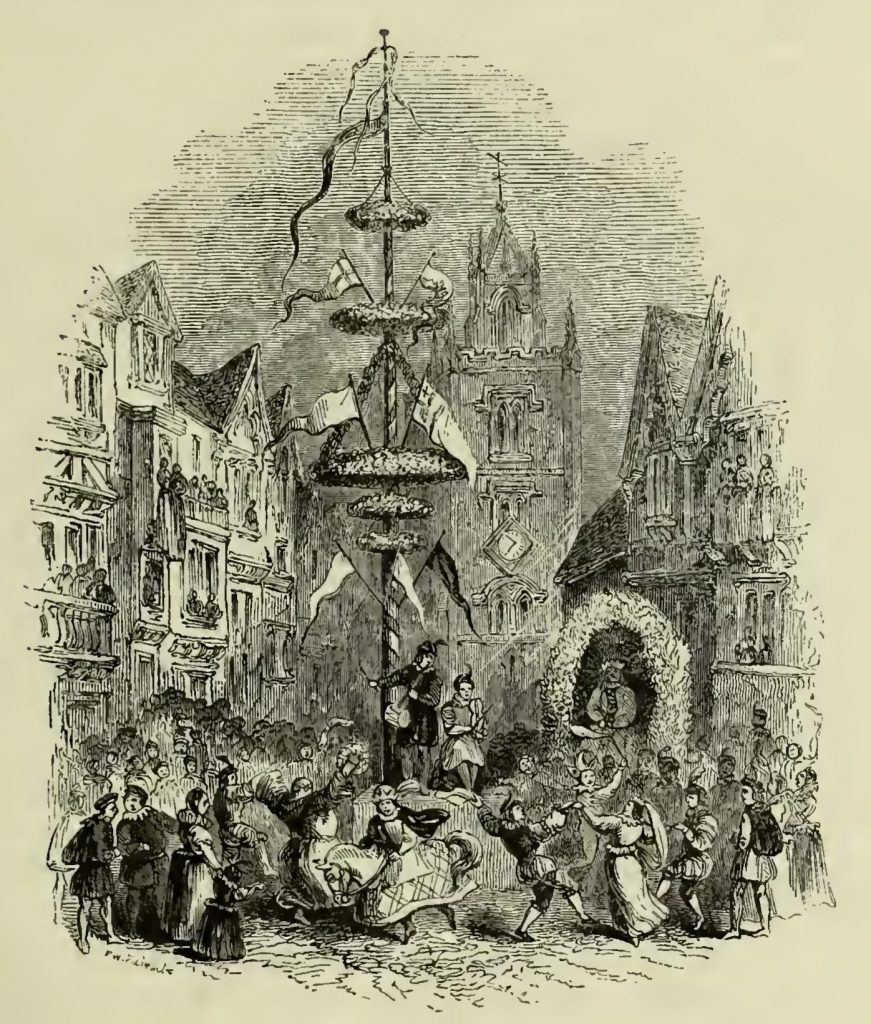
Philip Stubbes, in his Anatomy of Abuses of 1583, fired a broadside at the tradition of dancing around the Maypole when he wrote a vitriolic attack on pagan practices. He said they had ‘as Superintendent and Lord ouer their pastimes and sportes: namely, Sathan Prince of Hell’ as they erected ‘this stinking Idoll’. Stubbes suggested that of the maids that went out to the woods on May Eve less than one-third returned ‘undefiled’.
The Maypole was stored at St Andrew Cornhill, which became known as St Andrew Undershaft. In 1517, it was attacked during the ‘Evil May Day riot’, which the Recorder of the time, Thomas More, helped quell. (300 were arrested and one hanged). The shaft was returned to its place under the eves of the houses in Shaft Alley, but apparently banned from being raised.
But in 1549, the curate of nearby St Katharine Cree Church made an inflammatory speech which led to a Puritan mob cutting the shaft into pieces and burning it. I always imagine the Curate’s sermons to be along the same lines as Phillip Stubbes attack on the Maypole:
‘But their chiefest iewel they bring from thence is the Maie-poale,
which they bring home with great veneration, as thus: They haue
twentie, or fourtie yoake of Oxen, euery Oxe hauing a sweete
Nosegaie of flowers tyed on the tip of his homes, and these Oxen
drawe home this Maie-poale (this stinking ldoll rather) which is
couered all ouer with Flowers and Hearbes, bound round about
with strings from the top to the bottome, and sometimes painted
with variable collours, with two or three hundred men, women and
children following it, with great deuotion. And thus being reared
vp, with handkerchiefes and flagges streaming on the top, they
strawe the ground round about, bind green boughes about it, set
vp Summer Haules, Bowers, and Arbours hard by it. And then fa!
they to banquet and feast, to leape and daunce about it, as the
a Heathen people did, at the dedication of their ldolles, whereof this
is a perfect patteme, or rather the thing it selfe. I haue heard it
crediblie reported (and that viua voce) by men of great grauity,
credite, and reputation, that of fourtie, threescore, or a hundred Maides,
going to the wood ouemight, there haue scarcely the third part of them returned home againe vndefiled.‘
Phillip Stubbes from ”A Critical Edition Of Philip Stubbes’s Anatomie Of Abuses‘ By Margaret Jane Kidnie.
The unraised pole seems to have survived until the beginning of the Civil War, (1644) when it was destroyed. But at the Restoration of Charles II a new and huge Maypole was joyously erected 134 ft high (41 metres) in the Strand. This was danced around till 1713 when it was replaced and the original sold to Isaac Newton who used it to support the biggest telescope in Europe which was erected in Wanstead by a friend.
And that, my friends, is how you get from Superstition to Science in one easy story.

Postscript. I have always said that the sermon that led to the destruction of the Shaft in 1549 was made at St Paul but cannot remember where I read this. The suggestion that the Maypole in Cornhill was not used after 1517 seems strange because why then would it rouse a crowd to riot in 1549? Of the sources I have at hand, the London Encyclopedia mentions the riot of 1517 in its entry on St Andrew Undershaft but doesn’t elaborate more. ‘Layers of London‘ says ‘It was last raised in 1517 when ensuing riots led to the celebration being banned.’ which is definitive sounding. But is it? I wonder if it was banned for a year or two, then allowed again, and finally stopped in 1549?
First written in 2023 and revised on May 2nd 2024.
May Day May 1st
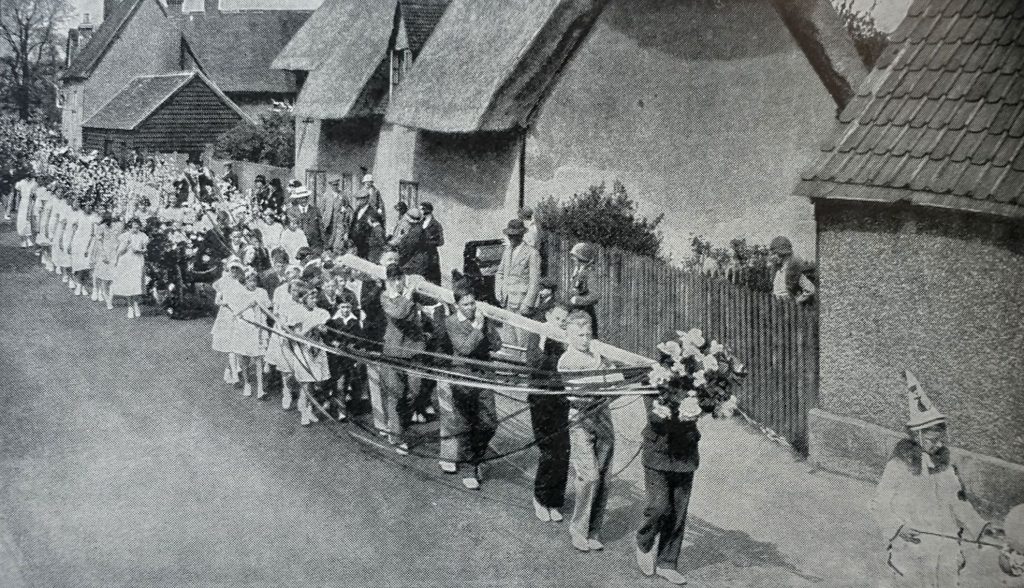
Maypoles were often stored during the year. A few days before May Day they were repainted, and bedecked with May Garlands – mostly made from Hawthorn. The Maypole used in London in 1660 was 134 feet high. Tall straight trees were used, sometimes of Larch, and they might be spliced together to get the requisite height. John Stow says that each parish in London had their own Maypole, or combined with a neighbouring Parish. The main Maypole was on the top of Cornhill, in Leadenhall Street, and it was stored under the eves of St Andrew’s Church which became known as St Andrew’s Undershaft as a result.
Padstow holds, perhaps, the most famous May Day festival on May 1st. Padstow feels very ‘pagan’ or do I mean it is fuelled by an enormous amount of drink?
Here is a video, watch until you see the ‘obby ‘orse and the teaser dancing.
The celebrations begin on May Eve because the Celtic calendar starts the day at Dusk. This seems strange to us even though we perversely ‘start’ our day at Midnight just after everyone has gone to bed! The other choice, and maybe the most logical is, Dawn, but Dawn and Dusk are difficult to fix. Midnight was chosen by Julius Caesar when he created the Julian Calendar. Midnight has the virtue of being a fixed metric, being half way between Dawn and Dusk.
Celebrations centred around the Bonfire, and for the Celts was sacred to the fire God Belinus, and May Day was called Beltane. Bonfires continued to be a part of the celebration into the 16th Century, and in places until the 20th Century. According to folklore tradition, the bonfire should be made of nine types of wood, collected by nine teams of married men (or first born men). They must not carry any metal with them and the fire has to be lit by rubbing oak sticks together or a wooden awl twisted in a wooden log. The people have to run sunwise around the fire, and oatcakes are distributed, with one being marked with a black spot. The one who collects it has to jump through the fire three times. Bonfires would have been on the top of hills, or in the streets in London.
May celebrations have a similarity to Halloween, which was also a fire festival and both are uncanny times when sprites and spirits abound. Hawthorn was a favoured wood not only because of its beautiful may flower but also because it was said to be the wood the crown of thorns was made from. It had the power of resisting supernatural forces, so was used to protect doors, cribs, cow sheds and other places from witches. Witches, it was said, got their power to fly from potions made from chopped up infants. The best protection was Christening and the custom was that christening took place as early as possible and normally three days after birth. Shakespeare was baptised on 26th April 1564, so we celebrate his birthday on 23rd April. See my post for more on this subject.
Cribs would be bedecked with Hawthorn and protection might be augmented by a bible, rowan, and garlic. Babies born between May 1 and 8 were thought to be special children destined to have power over man and beast. Weddings were frowned upon in Lent and in May, so April became a popular choice for marriage.

After celebrations in the evening of April 30th, women would go out in the woods to collect May, other flowering plants, and to wash their faces in May Dew preferable from the leaves of Hawthorn, or beneath an oak tree, or from a new-made grave. The dew was said to improve their complexion and was also used for medical conditions such as gout and weak eyes. Thinking of one’s lover on May Day might bring marriage within the year.
May morning would commence with dancing around the Maypole, followed by feasting, and summer games.

Walpurgis Nacht April 30th

On April 30th, 870AD, St. Walpurga remains were ‘translated’ to Eichstätt, which St Willibald had set up as the Diocesan centre of this part of Bavaria. The evening of April 30th is the beginning of Beltane, the Celtic Fire Ceremony that is 6 months before Halloween, and the beginning of Summer. The Celtic Day began at Dusk, so May Day begins on 30th April. The Christian Church took many local traditions and adapted them to the calendar of the Church, so a Saint’s Day, is preceded by an Eve, All Hallows’ Day and Halloween, and May Day and May Eve. Walpurgisnacht is also halfway between the Spring equinox and the Summer solstice.
As May Day was an uncanny period dedicated to Pagan Deities, it makes sense for Walpurgisnacht to be a time when all the weird things are alive in the world, and for the Christian Church to adapt a saint associated to that day to be a focus for defeating witchcraft. So, it is a popular tradition for this Night to see the burning of an effigy of a witch on a bonfire.
In Germany today it is known as Walpurgisnacht, in Sweden Valborg and as Čarodejnice in the Czech Republic.
Walpurgisnacht has really been taken over by Heavy Metal, and I refer you this page to begin your journey down a dark rabbit hole of head-banging rock. https://astromagicklounge.com/2021/04/30/celebrating-walpurgis-night-with-black-sabbath-aleister-crowley/
I wrote more on my page on St. Walpurga’s feast day, February 25th.
Time to guard children against witches April 29th
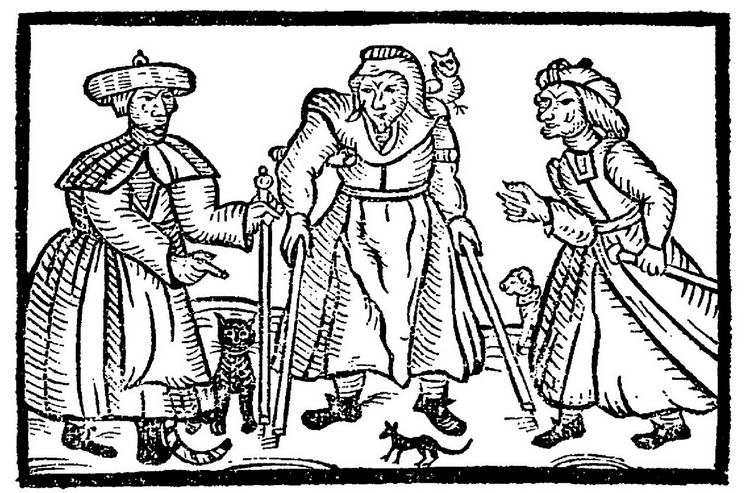
As May Eve approached, which like Halloween, was considered a particularly uncanny time, people were warned to guard against witches stealing their babies:
He (the Devil) teacheth the witches to make ointments of the bowels and members of children, whereby they ride in the air and accomplish all their desires. So as, if they be any children unbaptized, or not guarded with the sign of the cross or orisons: then the witches may and do catch them from their mother’s side at night, or out of their cradles. …. and after burial steal them out of the graves, then seethe them in a cauldron until their flesh been made possible.
Reginald Scott ‘The Discovery of Witchcraft’ 1594 (from ‘The perpetual Almanack of Folklore’ by Charles Kightley)
Ways to keep witches away were various, but baptising your children early was the best method. As you will have seen in previous posts, children were normally baptised as soon as three days after birth in the early modern period.) Saying prayers (orisons), hanging garlic, bread, rowan-leaves, around the cradle were among many other methods that could be used in those days of a homicidal fear of witchcraft.
In archaeological surveys of timber framed buildings increasing numbers of reports of ‘witches’ marks have been discovered. They are now so ubiquitous that it seems most people felt the need to deploy them to secure their houses. It was believed that witches gained entry where there was in inlet of wind, so doors, windows, chimneys, and anywhere there was a draft. These were be marked by pentagons which represent the five wounds of Christ, as well as a variety of other marks ‘chequerboards, mesh patterns, peltas (a type of knotwork design) and circle’. This quotation is from https://theartssociety.org/arts-news-features/ancient-symbols-once-used-ward-away-witches which is an excellent read and gives more detail.
Also this article makes the case that they are not witch marks, or anti-witch protection marks but general marks to ward off evil. This is worth reading. The illustration below comes from it.

Robert Burns poem ‘Tam O’Shanter’ gives a graphic, fictional, account of a witches’ coven presided over by the Devil (auld Nick) himself which features ‘wee, unchristen’d bairns‘:
And, vow! Tam saw an unco sight!
Warlocks and witches in a dance;
Nae cotillion brent new frae France,
But hornpipes, jigs, strathspeys, and reels,
Put life and mettle in their heels.
A winnock-bunker in the east,
There sat auld Nick, in shape o’ beast;
A towzie tyke, black, grim, and large,
To gie them music was his charge:
He screw’d the pipes and gart them skirl,
Till roof and rafters a’ did dirl.—
Coffins stood round, like open presses,
That shaw’d the dead in their last dresses;
And by some devilish cantraip slight
Each in its cauld hand held a light.—
By which heroic Tam was able
To note upon the haly table,
A murderer’s banes in gibbet airns;
Twa span-lang, wee, unchristen’d bairns;
A thief, new-cutted frae a rape,
Wi’ his last gasp his gab did gape;
Five tomahawks, wi’ blude red-rusted;
Five scymitars, wi’ murder crusted;
A garter, which a babe had strangled;
A knife, a father’s throat had mangled,
Whom his ain son o’ life bereft,
The grey hairs yet stack to the heft;
Wi’ mair o’ horrible and awefu’,
Which even to name wad be unlawfu’.
I talked more about Tam O’Shanter and the Cutty Sark here and to read the whole poem see below. Please do have a look and when you read it read it quick and don’t worry about how to pronounce it or understand it, just enjoy the ride!
Written in 2023 revised April 2024
Boating adventure & the Second Best Modernist Building in London

What makes owning a Narrow Boat so wonderful, apart from enjoying living amidst nature, is the accidental discovery of undreamt of wonders. Last week, I moved my narrow boat from Westbourne Park to Perivale. A 3-hour boat trip of less than 10 miles to a frankly uninspiring suburb. But, as so often, mooring in an uninspiring place uncovered surprises that transform the mundane to the delightful.

We set off on a beautifully sunny April morning to move the boat the requisite distance to satisfy licence terms. Rain at 12 prompted a premature end to the trip. We trudged to Perivale Underground Station, bemoaning the failure to get to Southall, to enjoy a Little India’s Dosa.
The road to Perivale is dull suburbia. But we stopped at a library boasting a cafe, which turned out to be a really nice bit of early 20th Century library architecture, with a cheerful volunteer explaining they were keeping the library from closure due to council cost-cutting.

They had made the library really cosy with sofas and comfortably sitting areas, but the promised Cafe was not open.

The volunteer pointed us in the direction of a sandwich at the Tesco in the Hoover Building. I had no idea this icon of Modernism was a short walk away, so we jumped at the chance to see, at close range, one of my favourite London buildings.

I regularly point it out to the groups I take to Oxford. But I have never seen it up close nor standing still. Not only is the building a fabulous white colour with colourful features, but it has a backstory of interest in London’s history. As road transport began to remake the geography of London, factories in Hackney, Tower Hamlets, Southwark, Lambeth, and other Inner London Boroughs closed, and new factories were constructed on the roads out of London, mostly manufacturing consumer goods. Park Royal, Greenford, Slough and Staines were among the areas to develop as consumerism powered the 20th Century with the production of irons, kettles, hairdryers, radios, washing machines, and vacuum cleaners. The fields around were turned into rows of semi-detached houses to mortgage to the workers.







Above, ‘The Hoover Building is a Grade II* listed building of Art Deco architecture[1] designed by Wallis, Gilbert and Partners located in Perivale in the London Borough of Ealing.The site opened in 1933 as the UK headquarters, manufacturing plant and repairs centre for The Hoover Company.[2]‘ (Wikipedia). It has been converted to apartments and a Tesco occupies the Factory Floor.
What made this trip even more special is that one of the buildings has become a Hotel, which we explored and discovered it had a massive Indian Restaurant. Inside, we found it was full with about 500 people eating a fast-breaking Eid dinner. £26 to eat as much as you can, all self-service, with scores of chefs serving their delicious tureens of Asian food.
If I’m passing the factory on a tour, I tend to read to my group Sir John Betjeman’s patronising poem ‘Slough’ which is about the horror of the new consumer society. ‘Slough’ is wonderful to read and, yet, absolutely awful, not just the Oxbridge author looking down his long privileged nose at the lower classes but going to the extreme of suggesting Slough would be better off bombed to smithereens.
Guernica was bombed on 26th April 1937 and ‘Slough appeared’ in a Betjeman collection called ‘Continual Dew’ in the same year (I havent located a reference with the actual date of publication). Bad taste in the extreme, hardly mitigated by the fact that it was originally written in 1928 and was about trading estates in general rather than Slough in particular. Still, despite all it is still one of my favourite poems for the insight it gives to attitudes of the British class system.
So, here it is.
Slough
Come friendly bombs and fall on Slough!
It isn’t fit for humans now,
There isn’t grass to graze a cow.
Swarm over, Death!
Come, bombs and blow to smithereens
Those air-conditioned, bright canteens,
Tinned fruit, tinned meat, tinned milk, tinned beans,
Tinned minds, tinned breath.
Mess up the mess they call a town-
A house for ninety-seven down
And once a week a half a crown
For twenty years.
And get that man with double chin
Who’ll always cheat and always win,
Who washes his repulsive skin
In women’s tears:
And smash his desk of polished oak
And smash his hands so used to stroke
And stop his boring dirty joke
And make him yell.
But spare the bald young clerks who add
The profits of the stinking cad;
It’s not their fault that they are mad,
They’ve tasted Hell.
It’s not their fault they do not know
The birdsong from the radio,
It’s not their fault they often go
To Maidenhead
And talk of sport and makes of cars
In various bogus-Tudor bars
And daren’t look up and see the stars
But belch instead.
In labour-saving homes, with care
Their wives frizz out peroxide hair
And dry it in synthetic air
And paint their nails.
Come, friendly bombs and fall on Slough
To get it ready for the plough.
The cabbages are coming now;
The earth exhales.
850 new factories were built in Slough before the outbreak of world war two, and the Trading Estate was first seen here. And yes, they are bleak, and Slough is even now, not the most exciting or architecturally sophisticated town. But to imagine bombing a town in a time when there was a real fear of mass destruction from the air?
I particularly object to the line about tinned food because I was brought up on tinned beans, peas, steak and kidney pudding, pineapple chunks, peaches, and rhubarb. And exactly what is wrong with a hair-dryer?
Before I read Slough I recount an experience I had years ago with a American group who suddenly started laughing for no reason. I enquired and they pointed to a huge advertising hoarding with a poster about the Electrolux Vacuum Cleaner. It’s location near the Hoover building may have been accidental but what made them laugh was the slogan:
‘Nothing sucks like an Electrolux’
To a British person the slogan works in a positive sense and we appreciate the wit. For the Americans it made them all laugh with shock as to why anyone would pay to say their vacuum cleaner was complete pants.
Oh, and second best? Well the best is the Daily Express Building, Fleet Street.
Floralia. Old Goats and an extraordinary Elephant April 28th

On the 28th of April until the Kalends (15th) of May the Romans, according to Ovid in the ‘Fasti’ Book IV, celebrated the Florialia dedicated to Flora, the Goddess of Spring, flowering, blossoming, budding, planting and fertility. She was one of the 15 Roman Deities offered a state-financed Priest. Her home in Rome, was on the lower slopes of the Aventine Hill near the Circus Maximus.

Celebrations began with theatrical performances, at the end of which the audience were pelted with beans and lupins. Then there were competitive games, and spectacles. The latter, in the reign of Galba, including a tight-rope walking – wait for it – elephant!
Incidently, Galba only survived for 7 months as Emperor – a little longer than Liz Truss’s 44 days but then she was not murdered by a rampaging mob at the end of her reign. It was the year known to history as the year of the 4 Emperors. (great description by Tacitus here:)
Juvenal records that prostitutes were included in the celebration of Flora by dancing naked, and fighting in mock gladiatorial battles. (there is a raging debate about the existence of female gladiators: a burial in Southwark has been said to be one such and Natalie Haynes has her say on the subject here🙂
Hares and goats were released as part of the ceremonies, presumably because they are very fertile and have a ‘salacious’ reputation! (Satyrs were, famously, obsessed with sex and were half man half goat. A man can still be referred to, normally behind his back, as an ‘old goat’).
Written in 2023 revised April 2024
